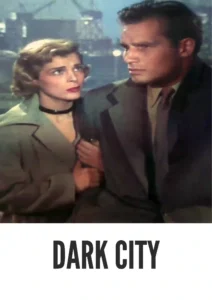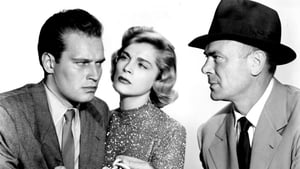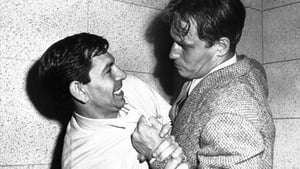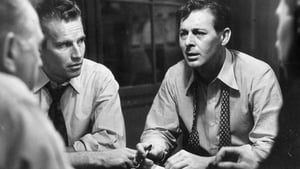Contact: info@alwanfilm.com
Video Sources 0 Views
- Watch trailer
- Dark City


Synopsis
Table of Contents
ToggleReview: Dark City 1950 Colorized – A Gritty Noir Thriller with Noir Elements

Introduction
Dark City, released in 1950, stands as a gripping film noir that immerses audiences in a world of shadows, deceit, and moral ambiguity. Directed by William Dieterle, this atmospheric thriller captivates viewers with its moody cinematography, complex characters, and suspenseful storyline. In this review, we’ll delve into the dark and mysterious world of Dark City and explore its enduring legacy in the realm of classic cinema.
Check The Full Colorized Movies List
Check Our Colorized Movies Trailer Channel
Understanding Dark City 1950 Colorized: Director, Cast, and Genre
Directed by William Dieterle, Dark City features a talented cast led by Charlton Heston as Danny Haley, Lizabeth Scott as Fran Garland, and Viveca Lindfors as Victoria Winant. The film falls within the genre of film noir, characterized by its shadowy visuals, cynical protagonists, and themes of crime and corruption.
Exploring the World of Dark City 1950 Colorized: Plot and Characters
Set in a gritty urban landscape, Dark City follows the story of Danny Haley, a cynical gambler who becomes embroiled in a dangerous game of deception and betrayal. As Danny navigates the treacherous underworld of organized crime, he must confront his own demons and grapple with the consequences of his actions.
The Art of Film Colorization
While Dark City was originally filmed in black and white, its early colorized version adds a new layer of visual richness and depth to its atmospheric aesthetic. The colorization process enhances the film’s moody lighting and shadowy visuals, capturing the bleakness of its urban setting with stunning clarity.
Early Colored Films: A Brief History
The history of early colored films is marked by innovation and experimentation as filmmakers sought to enhance the visual appeal of their movies. From hand-tinted frames to pioneering technicolor processes, the evolution of colorization techniques transformed the cinematic landscape, offering audiences a new way to experience classic stories and dynamic visuals.
Dark City (1950) and Its Early Colored Version
The decision to release Dark City in a colorized format was made with the intention of immersing audiences in the atmospheric world of the film and enhancing its visual impact. While some purists may prefer the original black and white version, the early colorized edition of Dark City adds a new dimension to its moody aesthetic and captures the intensity of its noir atmosphere with stunning clarity.
The Debate Over Film Colorization
The debate over film colorization continues to divide audiences and industry professionals alike. While some argue that colorization breathes new life into classic films and makes them more accessible to modern audiences, others maintain that it compromises the artistic integrity of the original work. As technology advances and filmmaking techniques evolve, the debate over colorization remains a topic of ongoing discussion within the film community.
Examining Dark City (1950) as an Early Colored Film
Viewing Dark City in its early colorized iteration offers audiences a fresh perspective on its atmospheric visuals and noir atmosphere. The colorization process enhances the film’s moody lighting and shadowy aesthetics, capturing the intensity of its urban setting with stunning clarity. As Danny Haley delves deeper into the seedy underbelly of his city, viewers are drawn into a world of intrigue and danger that resonates with timeless relevance.
Influence and Legacy: Dark City 1950 Colorized’s Impact on Cinema
Dark City is widely regarded as a classic example of the film noir genre that continues to captivate audiences with its atmospheric visuals, complex characters, and suspenseful storyline. Its enduring legacy has inspired generations of filmmakers and remains a beloved favorite among fans of classic Hollywood cinema. As a testament to its lasting impact, Dark City remains a powerful exploration of the human condition that continues to resonate with audiences around the world.
Director’s Cinematic Legacy: Beyond Dark City 1950 Colorized
William Dieterle’s directorial legacy extends beyond Dark City, encompassing a diverse body of work in film and television. As a filmmaker, Dieterle was known for his ability to create compelling narratives that delved into the complexities of human nature and the darker aspects of society. Dark City stands as a testament to his talent and creativity, solidifying his reputation as one of the great directors of classic Hollywood noir.
Themes Explored in Dark City 1950 Colorized
At its core, Dark City explores themes of crime, corruption, and moral ambiguity. Through its cynical protagonist and shadowy visuals, the film delves into the darker aspects of human nature and the consequences of greed and betrayal. As Danny Haley navigates the dangerous underworld of organized crime, viewers are confronted with the harsh realities of life in the city.
Reception and Controversy Surrounding Dark City 1950 Colorized
Upon its release, Dark City received widespread critical acclaim for its atmospheric visuals, complex characters, and suspenseful storyline. While the decision to release the film in a colorized format sparked debate among fans and critics alike, its enduring popularity has cemented its status as a beloved classic of American cinema.
Where to Watch Dark City 1950 Colorized Online
For those eager to experience Dark City for themselves, the film is readily available on popular streaming platforms such as Amazon Prime Video, Google Play Movies, and iTunes. Whether viewed in its original black and white format or its early colorized iteration, Dark City offers a gripping cinematic experience that is sure to captivate audiences.
FAQs About Dark City 1950 Colorized
1. Is Dark City based on a true story?
No, Dark City is a fictional film noir that explores the seedy underworld of organized crime and moral corruption. While the film’s storyline may draw inspiration from real-life events and experiences, its characters and plot are works of fiction.
2. Who starred in Dark City?
Dark City stars Charlton Heston as Danny Haley, Lizabeth Scott as Fran Garland, and Viveca Lindfors as Victoria Winant. Their compelling performances bring depth and intensity to the film’s noir atmosphere, capturing the intrigue and danger of life in the city.
3. What is the central message of Dark City?
At its core, Dark City examines the consequences of crime, corruption, and moral compromise. Through its cynical protagonist and shadowy visuals, the film delves into the darker aspects of human nature and the price of betraying one’s principles in pursuit of power and wealth.
4. Why was Dark City released in a colorized format?
The decision to release Dark City in a colorized format was made with the intention of enhancing the film’s visual appeal and capturing the intensity of its noir atmosphere. While some purists may prefer the original black and white version, the early colorized edition of Dark City adds a new dimension to its moody aesthetic and offers audiences a fresh perspective on this classic thriller.
5. What is the legacy of Dark City?
Dark City is widely regarded as a classic example of the film noir genre that continues to captivate audiences with its atmospheric visuals, complex characters, and suspenseful storyline. Its enduring legacy has inspired generations of filmmakers and remains a beloved favorite among fans of classic Hollywood cinema.
6. Are there any sequels or remakes of Dark City?
No, there have been no official sequels or remakes of Dark City. However, the film’s enduring popularity has inspired countless imitations and reinterpretations in various media. Nonetheless, none have captured the gritty atmosphere and suspenseful storytelling of the original 1950 classic.
7. Where can I watch Dark City online?
For those eager to experience Dark City for themselves, the film is readily available on popular streaming platforms such as Amazon Prime Video, Google Play Movies, and iTunes. Whether viewed in its original black and white format or its early colorized iteration, Dark City offers a gripping cinematic experience that is sure to captivate audiences.
Conclusion
In conclusion, Dark City (1950) stands as a gripping film noir that continues to enthrall audiences with its atmospheric visuals, complex characters, and suspenseful storyline. Whether viewed in its original black and white format or its early colorized iteration, William Dieterle’s masterful direction and the compelling performances of the cast offer a cinematic experience that is both immersive and thought-provoking. As Danny Haley navigates the treacherous underworld of organized crime, viewers are drawn into a world of shadows and deceit that resonates with timeless relevance. With its enduring legacy and universal themes, Dark City remains a powerful exploration of the human condition that continues to captivate audiences around the world.













